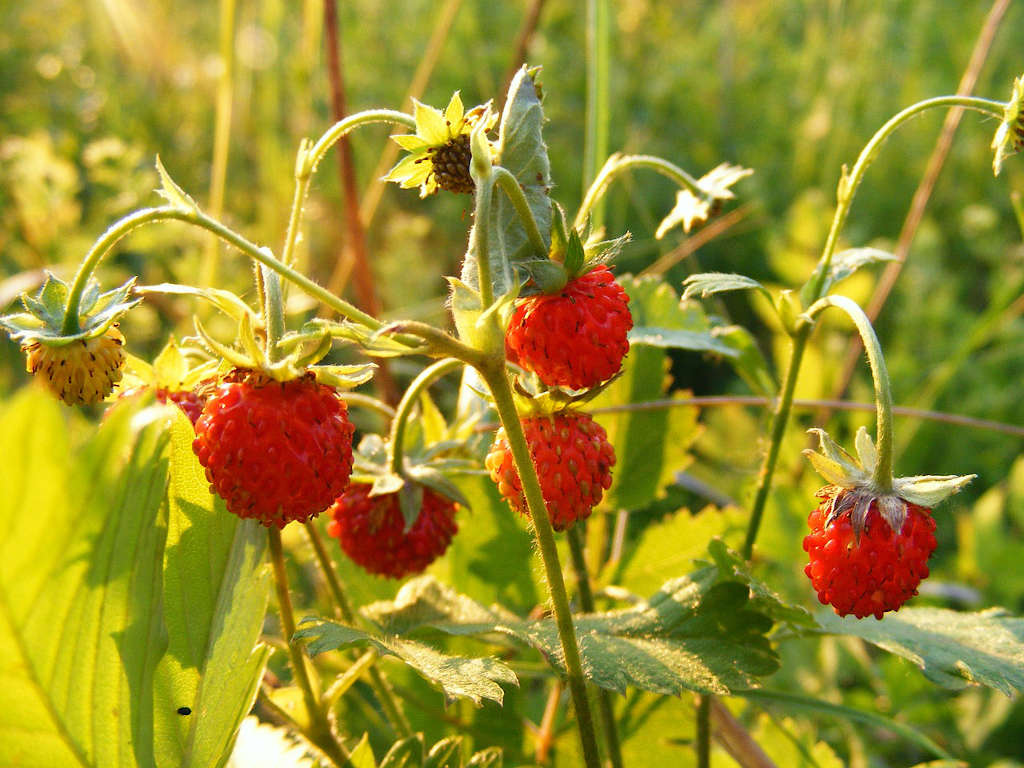
Wild Strawberry (Fragaria vesca)
I adore wild strawberries! As far as I am concerned they are the ULTIMATE wild food. I love bilberries too, or raspberries, or blackberries, for that matter, but nothing on this earth beats wild strawberries. When their season comes, I eagerly check all my favorite gathering grounds to make sure they are progressing nicely. I try to restrain myself, but inevitably I end up picking some prematurely, not half the delight as the fully ripened berries – so I leave them be and just keep coming back to see how they are progressing. Happily, wild strawberry is one of those plants whose season is quite prolonged. Depending on factors such as exposure to sunlight and altitude it is possible to harvest them over a period of a couple of months. Of course, competition from birds and slugs can be tough.
It is not just the flavor I love about these precious little berries – it’s everything: The innocent appearance of their dainty little flowers would never lead one to suspect the scrumptious surprise their cute little berries will yield. Some foragers find picking them a tedious task – this may be true, but the effort is so richly rewarded. Unfortunately, I rarely manage to gather enough to take home for later. Most of them go straight from the plant to the gullet, without much further ado. I just can’t help myself. I have convinced myself that they don’t last very well and that even in the short space of time it would take to get them home they would lose too much of their deliciousness. Best to just eat them on the spot. This is the true and honest reason why I can’t give any recipes that I have actually tried and tested myself. But I am quoting other sources who evidently have a larger patch closer to home, or are simply more disciplined. My personal recommendation would always be to eat them on the spot whenever you can and don’t tell anybody.
Medicinal properties
Dried strawberry leaves make a very good breakfast tea. The fruit are cooling and refreshing and are very useful for cooling feverish conditions. According to Linnaeus, they are also useful in the treatment of rheumatic gout. Particularly the leaves are highly effective in washing out uric acid crystals.
These days the plant is largely ignored in medical herbalism. The little berries are simply appreciated for their taste. But Hildegard von Bingen never liked the plant:
‘The herb on which wild strawberries grow is more warm than cold. This herb brings mucus to the person who eats it and is not as beneficial as a medicine. Indeed, the berries themselves make the mucus in the person who eats them. They are not good for a healthy or sick person to eat because they grow near the earth and because they also grow in putrid air.’
Respectfully, Frau von Bingen, I most profoundly disagree!
Mrs. Grieves has a greater appreciation, although she found it a bother to gather the little berries. She mentions an interesting cosmetic use of strawberries:
How to remove stains from teeth.
‘If the juice is allowed to stay on for about five minutes and the teeth are then cleansed with warm water to which a pinch of bicarbonate of soda has been added.’
Wild strawberries are also said to be effective in removing plaque and tartar from teeth.
Recipe
Mrs. Grieves also gives an old, somewhat elaborate recipe, which someone here might like to try:
‘Gather strawberry leaves on Lamas Eve (1 Aug) press them in the distillery until the aromatic perfume thereof becomes sensible. Take a fat turkey and pluck him, and baste him, then enfold him carefully in the strawberry leaves. Then boil him in water from the well, and add rosemary, velvet flower (?), lavender, thistles, stinging nettles, and other sweet-smelling herbs. Add also a pint of canary wine, and half a pound of butter and one of ginger passed through the sieve. Sieve with plums and stewed raisins and a little salt. Cover him with a silver dish cover.’
CAUTION: People prone to allergies should avoid strawberries.


